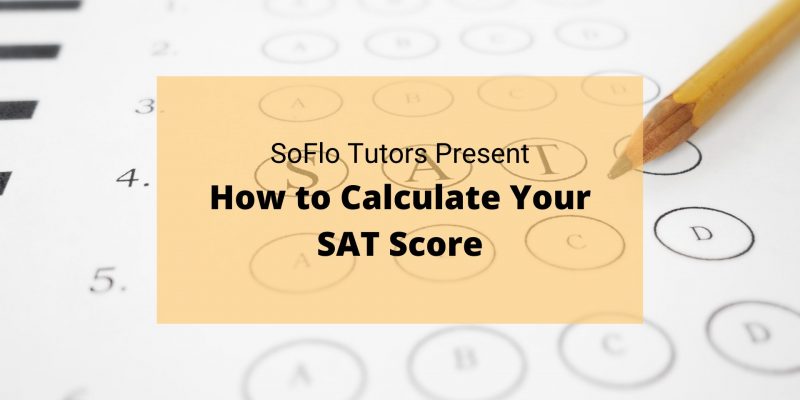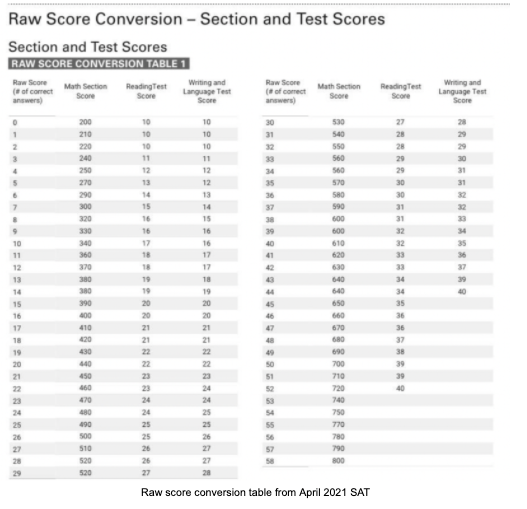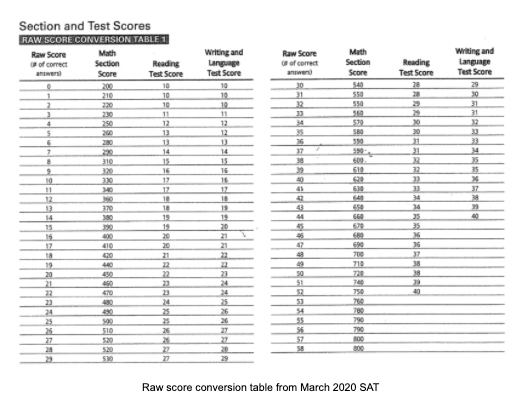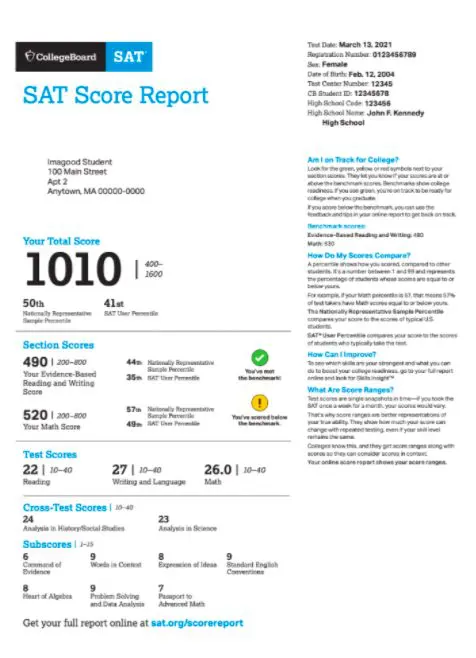
Although the SAT is broken up into four sections, it is only scored based on two categories: the Math section and the Evidence-Based Reading and Writing Section. The maximum score for both of these sections is 800. Adding these two subscores together will give a maximum composite score of 1600.
The Math test components are broken down into the “Math with calculator” and the “Math no calculator” pieces. The writing/reading part consists of a reading test and a writing and language assessment. It can be difficult to assess your achievement on these sections without understanding how the test is scaled and converted.
Scaling Your Raw Scores
To calculate these two section scores, the raw score is converted into a scaled score. The raw scores are purely the number of correct answers in each section. The SAT does not count against incorrect answers, meaning that there is no score deduction if you answer a question wrong. The raw scores are simply out of the number of questions in each section, however, the scaled score is measured from 200-800 points.
From your raw score, the Reading Test Score is calculated between 10-40, which is the same for your Writing and Language Test Score. When you add those two scores together the sum will range from 20-80, which, when multiplied by 10, will convert to your overall section score between 200-800. Your Math section is determined by the sum of the raw Math scores from the non-calculator and calculator parts. This total score is then converted into the overall 200-800 scale. This means that your total SAT score, including both Math and Reading, can range from 400-1600.
Test Differentiation
The test is scored in this scaled manner in an effort to keep the test standardized across multiple repetitions and versions across the tests. Each test is slightly different in terms of difficulty and content, which the scaled scoring system attempts to account for and correct. The SAT’s scaled scoring also means that one test isn’t easier than any other!
Since each test has slight differences, each test cannot be scaled according to the same raw score baseline. This means that missing one question can sometimes result in a 10 point difference and other times can result in not gaining 30 points on that section. Sometimes missing one question doesn’t have any effect at all and your overall score will remain at 800.
Sample Conversion Tables


As you can see from the above tables, the conversion scale fluctuates from test to test. Although the exact raw score conversions can vary, there is still a typical range in which you can expect to score based on how many questions you answer correctly in a section.
Typically, if you get 0-1 wrong answers on the Math section you score a perfect 800. If you miss 1-3 questions, you lose 10 points and score a 790. If you miss 10 questions, you can expect a Math section score in the 680-710 range. Missing 20 on this section would result in a score of around 600.
Similarly, if you miss 1 problem on both the Reading and Writing tests, you might get an Evidence based Reading and Writing section score of 780. Missing 10 questions on both of these subsections would result in the ~640 to ~660 score range. Missing 20 on each of these subsections would translate to a score around 530 – 550.
Understanding Your Scores
The most accurate way to assess your performance on the SAT is to understand your national percentile standing and your score in comparison to benchmark scores.

Each SAT score report offers percentile rankings for each section and composite score compared to other students in the United States. In the sample score report above, the student scored a 1010 overall which places them in the 50th percentile for their nation. This means that they scored better than 50% of other test takers who took the SAT. Under the “Section Scores” category, the student scored a 490 out of 800 in Evidence-Based Reading and Writing, which places them in the 44th percentile. To the right of this information, it tells you that the student met the benchmark for this section.
This “benchmark” score aims to predict if a student is college ready. This means that the benchmark score is what College Board determines as the threshold to say that a student has a high likelihood of succeeding in a college course specific to that subject. This doesn’t mean that you cannot be successful if you don’t hit the benchmark in a specific area, it just indicates that you might need extra preparation in that subject.
These numbers summarize the level of achievement that the student is currently at and provides subsequent steps to increase college or career readiness. College admissions will interpret this score report when reviewing applications. The photo above only shows page one of a score report, however, the actual score report will include many more pages of information regarding how the students performance can be interpreted and how to improve.
SoFlo SAT Tutoring
One way to improve scores if you aren’t meeting the benchmark is through tutoring. SoFlo SAT Tutoring offers services from high scoring students who attend top universities. Our online tutors have proven their mastery in the subject and provide individualized attention to other students. Check out our tutoring services to get started today and begin the journey to improving your own scores.
About the Author

Catie Mullin is a sophomore at the University of Southern California studying Psychology. She is an expert tutor with SoFlo Tutoring and scored a 33 on her ACT. While she’s from Boise, Idaho, she was actually born in Germany!










